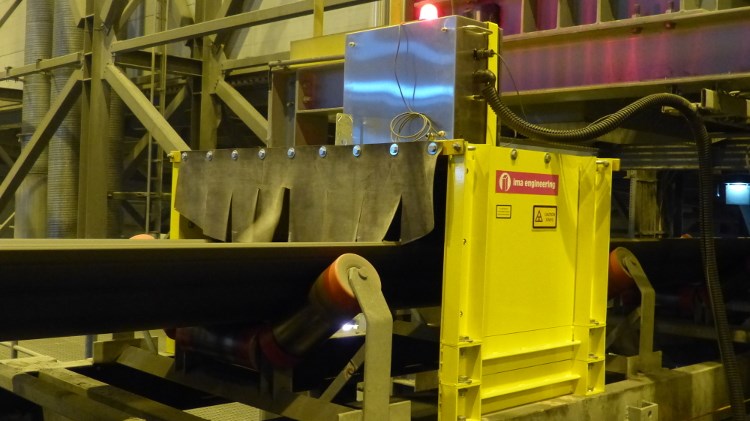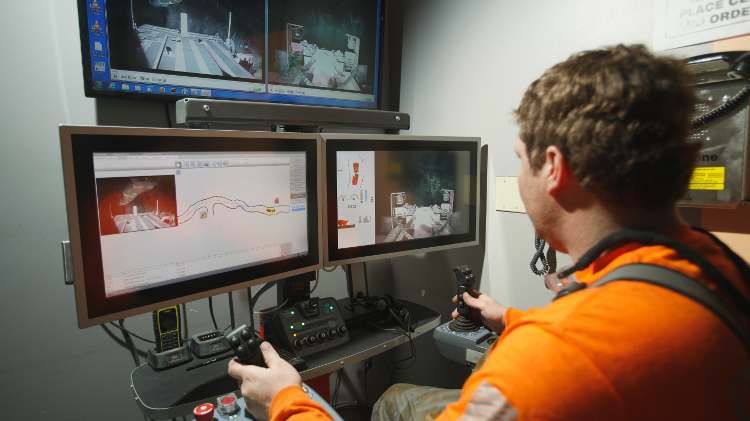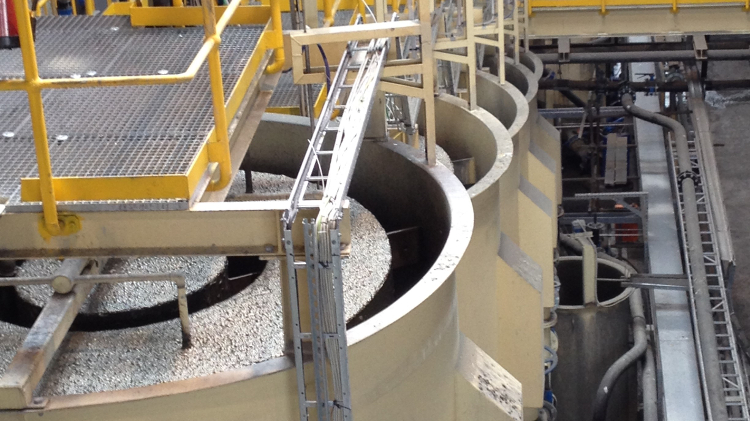Real Time Instruments’ AllScan uses a neutron-based radiation source to reveal the material’s elemental spectra. Courtesy of Real Time Instruments
Continuous, real-time chemical analysis of material on a conveyer belt represents a tremendous opportunity for the mining industry to improve efficiencies with better understanding and management of ore variability, from the pit right through to processing and the quality of the final product. Although the necessary technology has existed since the 1970s, when devices installed on conveyer belts that measured sample streams taken from the belt were first developed for the coal sector, it remains largely untapped in metal mining. After success in coal, material analysis technology was soon adapted for the cement industry, which took it one step further by creating the first devices, installed over the belt, that measured everything from moisture to elements, and that, instead of measuring samples, analyzed the actual stream in real time. Today, almost every new cement plant has been designed with at least one cross belt analyzer, according to Henry Kurth, minerals consultant for Scantech International. Eventually, the advancements bounced back to coal, but when it came to the minerals sector the adoption of cross belt analysis technology hit a rock wall.
“The minerals industry has always been reluctant to change,” said Kurth, who, like all manufacturers of cross belt analyzers, says these products can help mining operations get a better grip on ore variability. “It’s very hard getting a new technology into an industry. No one wants to be the first to try it.” His company has been slowly breaking through the wall with its Geoscan cross belt analyzer. Cross belt analyzers are practically unheard of in South and North America, according Philip Thwaites, manager of process control for XPS Consulting & Testwork Services. However, Scantech has installed more than 60 units globally at over 50 mining operations. One of those is for Assmang, which mines iron, manganese and chrome in South Africa. As far back as 2002, the company tested the technology in a production environment at its Beeshoek operations in the Northern Cape. Their findings “gave the required confidence and motivation to include these analyzers in some of our relatively new processes and plants,” said Kgobalale Motubatse, senior superintendent product quality for Assmang’s Khumani iron ore operations. The company also uses the technology at Khumani and their Black Rock site.
How cross belt analyzers work
Cross belt analyzers scan the material bed on the belt continuously and send instantaneous readings and weighted averages to the plant’s process control and production management systems, and the data can in some cases be stored on the cloud. The analyzers also send the information back to the mine so mining operations can be adjusted as needed. This “limits a lot of sampling and sample preparation errors and perceived errors that occur due to inherent bias during conventional sample-taking methods,” said Motubatse, adding that it also decreases “the total volume of samples that would have had to be taken within the processing plant sections.”
 IMA Engineering's FCA cross belt analyzer emits an intense X-ray beam to analyze the material's elements. Courtesy of IMA Engineering
IMA Engineering's FCA cross belt analyzer emits an intense X-ray beam to analyze the material's elements. Courtesy of IMA EngineeringIn simple terms, “these analyzers are used to check and ensure that the product from one stage to the next is within specified parameters,” said Will Robinson, regional manager for Real Time Instruments, the makers of the AllScan cross belt analyzer.
“On most mining applications the analyzer cost is recuperated in less than one year from commissioning, and cost saving for the mine is usually in excess of $1 million,” Robinson said. “For example, monitoring ore grade prior to shipping can make sure lower spec materials are diverted, and only acceptable grade material is loaded. Imagine the cost implications of a ship that sails halfway around the world only to be rejected when the ore is tested at the destination and found to be outside the required parameters.”
Although prices differ depending on the technology and manufacturer, the cost of a cross belt analyzer on average ranges between US$250,000 and US$500,000 per unit.
Different technologies
Cross belt analyzers come in a number of distinctly different technologies. Near-infrared (NIR) and laser-induced fluorescence (LIF) are two technologies that emit energy to the surface on the material, whose characteristics are analyzed based on how the energy is reflected back. X-ray fluorescence (XRF), used by IMA Engineering, the Finnish company behind the FCA cross belt analyzer systems, emits an intense X-ray beam that causes the different elements in the material to produce distinct fluorescent X-rays, making it possible to analyze it. These technologies primarily read part of the surface of the material.
 Scantech International's Geoscan analyzer uses PGNAA technology to penetrate the full depth of the material on the belt. Courtesy of Scantech International Pty Ltd.
Scantech International's Geoscan analyzer uses PGNAA technology to penetrate the full depth of the material on the belt. Courtesy of Scantech International Pty Ltd.
Real Time Instruments and Scantech use prompt gamma neutron activation analysis (PGNAA) for their cross belt analyzers, which many in the industry consider to be the leading technology because it penetrates through the full depth of the material on the conveyer belt. In PGNAA, a neutron-based radiation source above or beneath the conveyor generates neutrons that are absorbed by the material on the belt. The gamma rays emitted by the material reveal its elemental spectra. “The PGNAA technique sees right through that thickness, and it does that continuously,” said Kurth. “So it’s constantly measuring what’s on that belt through the full cross-section, the full width.”
Applications
“The applications for cross belt analyzers are wherever you put the material on the conveyer belt,” said Ilpo Auranen, chairman of IMA. Assmang, for example, uses the Geoscan for “trend monitoring of all processes from primary to final product, but not for product certification,” said Motubatse.
Although cross belt analyzers can also be used in the back end of mineral processing to measure final product quality, what makes the technology important for the mining sector is that it can analyze material far earlier than any other existing instrumentation, since they can be installed at the mine or pit generally after primary crushing, according to Thwaites. Cross belt analyzers, he said, assay the material, providing its chemical composition – its elements – rather than its mineral composition.
That’s important because with detailed assays, mining operations can get a much better grip on ore variability by identifying ore grades in different stockpiles for effective blending. “The thing with a lot of processing plants is that the more variable the feed quality, the less efficient they are, and the lower the recoveries,” said Kurth. “Most plants are designed on an average ore grade. They very rarely see the average ore grade. So, based on the quality of material coming in, you can then blend it so that the plant sees a consistent quality feed, and that actually increases metal recovery.”
Interestingly, some of the surface measurement technologies used for cross belt analyzers are also being applied in portable analyzers for exploration. For example, IMA has created a van called the Scanmobile that has its own mini conveyer belt and is used in exploration rock analysis.
Challenges
Although the technology has been proven in cement and coal, “in metal mining, we’re talking about measuring in much lower percentages,” said Auranen. “In copper, the ore grades are typically between 0.1 per cent and one per cent, whereas in limestone or coal, we’re talking about closer to 80 or 90 per cent.” Good calibration when the units are installed – as well as ongoing calibration maintenance – is thus critical. This involves taking lab samples to verify the cross belt analyzer’s results, with adjustments made to the modelling for fine tuning. According to Auranen, the calibration process after installation can take up to two weeks. “To get the benefit of the data accuracy, some consideration has to be given to how your calibration verification program is structured and resourced,” added Motubatse.
Although all the technologies are relatively low maintenance because they are non-contact, NIR, LIF and XRF scans are susceptible to dust interference. Safety is always a concern with radiation, but PGNAA cross belt analyzers use only a small amount of radioactive material, and models such as the Geoscan and AllScan are designed so that users are shielded from it.
Most experts agree that each of the different technologies has its ideal use – something that, in the past, was not always considered. “There can be a level of skepticism about cross belt analyzers,” said Graeme Turner, of Australian-based Downer Group, which helps mining companies assess their needs and the best-suited cross belt technology for them. “I think that comes from the fact that in the past sometimes the wrong technologies were installed in the wrong applications. You have to match the right technology with the right application and needs.” Everything from what is being measured to where in the cycle it is being measured, and if it is an underground mine or an open pit mine, needs to be considered to achieve the best match and the best cost.
One final reason minerals mining has been slow to adopt cross belt technology might just be a common human response to difficult problems: denial. “Until you actually own up to it and admit there’s a problem, the problem doesn’t exist,” said Kurth. “So until people start measuring stuff, they don’t recognize the problem. [We can measure] the extent of the problem they have with variability in ore grade or even product. As long as it’s on a conveyor, we can measure it.”






